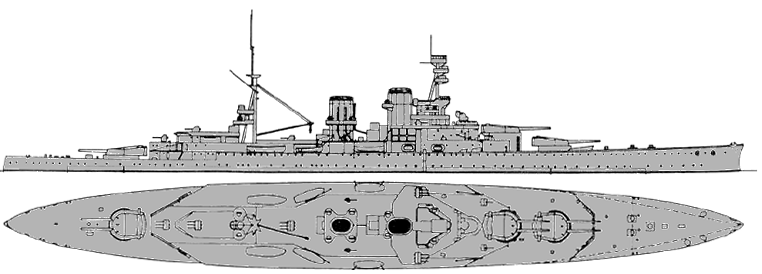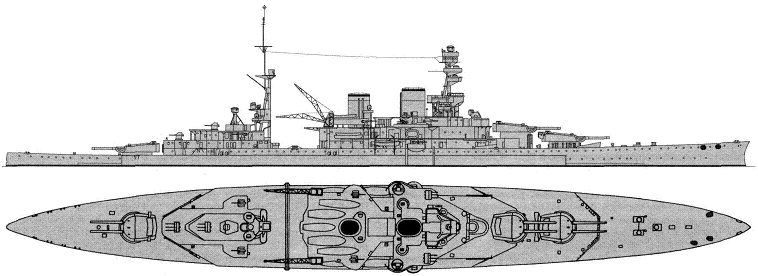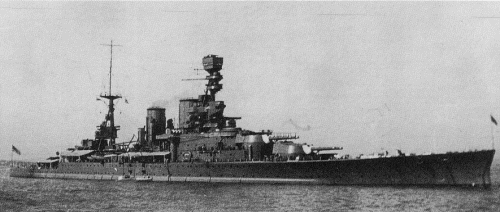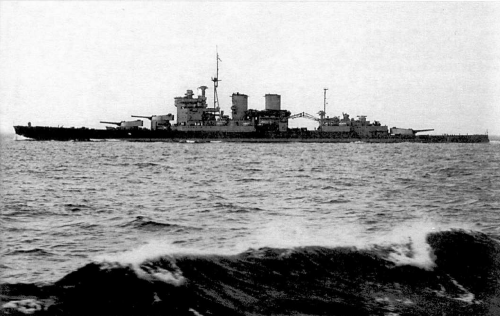

Repulse 1916

Repulse 1917

Renown 1917

Renown 1933

Repulse 1939

Repulse 1939

Repulse 1941

Renown 1939

Renown 1942

Renown 1943
| Name | No | Yard No | Builder | Laid down | Launched | Comp | Fate |
| Repulse | 54, 0A, 26, 34 | 443 | John Brown, Clydebank | 25.1.1915 | 8.1.1916 | 8.1916 | sunk 10.12.1941 |
| Renown | 64, 99, 23, 72 | 503 | Fairfield, Govan | 25.1.1915 | 4.3.1916 | 9.1916 | sold for BU 19.3.1948 |
| Data variant | as completed |
|
Displacement normal, t |
27650 |
|
Displacement full, t |
30835 |
|
Length, m |
242.0 |
|
Breadth, m |
27.4 |
|
Draught, m |
7.80 mean |
|
No of shafts |
4 |
|
Machinery |
4 Brown-Curtis steam turbines, 42 Babcock & Wilcox boilers |
|
Power, h. p. |
112000 |
|
Max speed, kts |
30 |
|
Fuel, t |
4243 oil |
| Endurance, nm(kts) | 3650(10) |
|
Armour, mm |
main belt: 152 - 76, upper belt: 38, bulkheads: 102 - 76, funnel uptakes: 38 - 25, turrets: 229 (face) - 178 (sides) - 108 (roof), barbettes: 178 - 102, main deck: 25 (51 over magazines) with 51mm slopes, forecastle deck: 31 - 19, CT: 254 |
|
Armament |
3 x 2 - 381/42 BL Mk I, 5 x 3 - 102/44 BL Mk IX, 2 x 1 - 102/44 BL Mk IX, 2 x 1 - 76/45 20cwt QF Mk I, 4 x 1 - 47/40 3pdr Hotchkiss Mk I, 2 - 533 TT (beam, 10) |
|
Complement |
967 |
Project history: The Admiralty had decided
that there would be no more battlecruisers after Tiger but they reckoned
without the return of Lord Fisher to the post of First Sea Lord in October 1914.
Capitalizing on the apparent vindication of Invincible class at the
Battle of the Falklands he was able to persuade the Cabinet to overturn its
decision to stop work on capital ships. In response to questions about the war
being over before the ships were finished, Fisher promised to build them as fast
as Dreadnought ten years earlier. That boast proved impossible but the
speed with which the two novel and complex ships were built was nonetheless a
great tribute to the efficiency of British shipbuilding and the DNC`s staff. As
was to be expected Fisher`s influence on the design was disastrous. He rightly
sought to use as much material as possible from the two contracts already placed
with Palmers and John Brown for Revenge class battleships, and built the
design around existing gun mountings, six sets of turntables and twelve 381mm
guns, part of the outfit for the battleships. But the old admiral`s belief that
speed was the best protection led him to armour the two ships on the scale of
Invincible, despite the fact that they would be facing enemy capital ships
armed with guns which could riddle 152mm belt armour.
Speed was everything, and a speed of 32kts was to be
achieved. The Engineer-in-Chief recommended the use of new lightweight
machinery, with lighter turbines and small-tube boilers but as time was short
the machinery of Tiger was duplicated, with three more boilers. Fisher`s
influence could also be detected in the choice of secondary armament. The ships
were given five triple 102mm mountings and two singles, arranged high up around
the superstructure. The P.XII mounting was very clumsy, with all three guns in
separate sleeves, and they required exceptionally large crews, 32 men. In theory
the arrangement of these mountings, one on either side of the forward
superstructure, one on the centreline between the funnels and the mainmast, and
two superfiring aft, gave a concentration of fire which was superior to a 152mm
battery, but this ignored realities as the triple mountings could not deliver a
volume of fire and the 102mm shell lacked range and stopping power.
When Repulse joined the Grand Fleet in August 1916 (Renown
joined a month later) the losses at Jutland had destroyed whatever reputation
the battlecruisers had ever had, and nobody could avoid the significance of the
long double row of scuttles amidships, indicating a vast area of hull
unprotected even by the thin strip of 152mm armour. So poor an impression did
they make that the C-in-C Sir John Jellicoe suggested in October 1916 that they
should both receive additional protection, and a month later Repulse was
taken in hand, followed by her sister in February 1917. This was only a
palliative, taking the form of 500t of additional plating on decks, particularly
over the crowns of magazines, over the engine rooms and over the steering gear.
Both ships had funnels of equal height when completed but
after trials the forward one was raised by 1.8m to cure interference from smoke.
Repulse was the first capital ship to receive a flying-off platform, in
the autumn of 1917.
Protection: Main 152mm belt was only 2.74m deep, reached between barbettes "A" and "Y". Lower edge of the belt based on the upper part of bulge, incorporating with slope of main deck. Fwd from the citadel the belt was 102mm, terminating approximately in 10m from stem by 102mm bulkhead. Aft from the citadel the main belt was 76mm, closed by 76mm bulkhead in 4m from stern. Upper belt had 38mm thickness. Funnel uptakes over forecastle deck were protected by 38 - 25mm plates.
Within the limits of citadel the main deck had thickness of only 25mm (already during construction its thickness over magazines had increased up to 51mm); slopes have been constructed from 51mm plates (fwd from barbette "A" and up to fore bulkhead the main deck had no slopes and was flat). Forecastle deck had thickness from 19 up to 31mm amidships.
The design of the hull contained a number of the innovations, to most interesting of which began advanced underwater protection, appreciably distinguished from used earlier. In this design "integrated" into a hull bulges for the first time have appeared. The maximal bulges width was 4.3m.
Ship Protection, Renown 1926: Main 229mm belt was 3.65m deep, reached between barbettes "A" and "Y". Lower part of main belt, 0.91m deep, tapered from 229mm at upper to 51mm at lower edge. Lower edge of the belt based on the upper part of bulge, incorporating with slope of main deck. Fwd from the citadel the belt was 102mm, terminating approximately in 10m from stem by 102mm bulkhead. Aft from the citadel the main belt was 76mm, closed by 76mm bulkhead in 4m from stern. Upper belt had 38mm thickness. Funnel uptakes over forecastle deck were protected by 38-25mm plates.
Within the limits of citadel the main deck had thickness of only 25mm (76mm over turbines and 102mm over magazines); slopes have been constructed from 51mm plates (102mm over turbines and magazines) (fwd from barbette "A" and up to fore bulkhead the main deck had no slopes and was flat). New 38mm plates were added over boilers between slopes and funnel uptakes at main deck level. Additional plates were applied over slopes (102mm over magazines and 63mm over machinery), increasing main deck area. Forecastle deck had thickness from 19 up to 31mm amidships. Lower deck over steering gear was 89mm and over magazines was 51mm thick.
Additional external bulges were fitted.
Ship Protection, Repulse 1936: Main 229mm belt was 2.74m deep, reached between barbettes "A" and "Y". Lower edge of the belt based on the upper part of bulge, incorporating with slope of main deck. Fwd from the citadel the belt was 102mm, terminating approximately in 10m from stem by 102mm bulkhead. Aft from the citadel the main belt was 76mm, closed by 76mm bulkhead in 4m from stern. There was an additional 102mm bulkhead abreast "Y" barbette. New upper belt had 152mm thickness. Funnel uptakes over forecastle deck were protected by 38-25mm plates.
Within the limits of citadel the main deck had thickness of only 25mm over boilers, 146mm over magazines from center of "A" barbette to fwd bulkhead of boiler room and from aft bulkhead of engine room to center of "Y" barbette. It was 89mm thick over turbines and 6m part aft from center of "Y" barbette. Main deck slopes have been constructed from 51mm plates (102mm over turbines and magazines). Fwd from barbette "A" and up to fore bulkhead 25mm main deck had no slopes and was flat. Forecastle deck had thickness from 19 up to 31mm amidships.
Ship Protection, Renown 1939: Main 229mm belt was 3.65m deep, reached between barbettes "A" and "Y". Lower part of main belt, 0.91m deep, tapered from 229mm at upper to 51mm at lower edge. Lower edge of the belt based on the upper part of bulge, incorporating with slope of main deck. Fwd from the citadel the belt was 102mm, terminating approximately in 10m from stem by 102mm bulkhead. Aft from the citadel the main belt was 76mm, closed by 76mm bulkhead in 4m from stern. Upper belt had 38mm thickness. Funnel uptakes over forecastle deck were protected by 38-25mm plates. "A" and "B" barbettes sides were strengthened up to 152mm between main and forecastle decks.
Within the limits of citadel the main deck had thickness of 76mm over boilers, 127mm over turbines and 102mm over magazines; slopes have been constructed from 51mm plates (102mm over turbines and magazines). Fwd from barbette "A" and up to fore bulkhead 25mm main deck had no slopes and was flat, short part of deck fwd from "A" barbette was 51mm. New 38mm plates were added over boilers between slopes and funnel uptakes at main deck level. Additional plates were applied over slopes (102mm over magazines and 63mm over machinery), increasing main deck area. Forecastle deck had thickness from 19 up to 31mm amidships. Lower deck over steering gear was 89mm and over magazines was 51mm thick. Additional 102mm armor over 114mm guns magazines was added at main deck level.
Modernizations: late 1916 - early 1917, both: increasing of main deck thickness up to 76mm over engine rooms (with 102mm slopes); additional plating at lower deck level, up to 89mm over steering gear and 51mm over magazines.
Autumn 1917, Repulse; Early 1918, Renown: + flying-off platforms on turrets "B" & "Y".
(Portsmouth DYd, 12.1918 - 1.1921), Repulse: 152mm main belt changed by 229mm one, thickness of upper belt rose up to 152mm, additional 102mm bulkhead was mounted abreast barbette "Y", main deck thickness over magazines rose up to 76mm with 102mm slopes. Additional external bulges made 30.8m beam, maximal draught rose to 9.60m; + 4 x 2 - 533 TT; full displacement: 37490t.
9/1921, Renown: - 1 x 3 - 102/44
11/1924, Repulse: - 2 x 1 - 102/44, 2 x 1 - 76/45; + 4 x 1 - 102/45 QF Mk V
(5/1923 - 8.1926) Renown: new main belt was 3.65m deep, its thickness decreased to 51mm at lower edge. Main deck and its slopes were 102mm. New 38mm plates were added over boilers between slopes and funnel uptakes. Additional plates were applied over slopes (102mm over magazines and 63mm over machinery). Additional external bulges were fitted; - 2 x 1 - 102/44, 2 x 1 - 76/45; + 4 x 1 - 102/45 QF Mk V, 1 x 3 - 102/44 BL Mk IX.
| Data variant | Renown, 1926 modernization |
|
Displacement standard, t |
32000 |
|
Displacement full, t |
37150 |
|
Length, m |
242.2 |
|
Breadth, m |
31.2 |
|
Draught, m |
9.53 deep load |
|
No of shafts |
4 |
|
Machinery |
4 Brown-Curtis steam turbines, 42 Babcock & Wilcox boilers |
|
Power, h. p. |
112000 |
|
Max speed, kts |
30.25 |
|
Fuel, t |
4243 oil |
| Endurance, nm(kts) | 3650(10) |
|
Armour, mm |
main belt: 229 - 76, upper belt: 38, bulkheads: 102 - 76, funnel uptakes: 38 - 25, turrets: 229 (face) - 178 (sides) - 108 (roof), barbettes: 178 - 102, main deck: 102 with 102-mm slopes over magazines, 76 over engines, 63 over boilers, forecastle deck: 31 - 19, CT: 254 |
|
Armament |
3 x 2 - 381/42 BL Mk I, 4 x 1 - 102/45 QF Mk V, 5 x 3 - 102/44 BL Mk IX |
|
Complement |
1205 |
3/1932, Renown: - 1 x 3 - 102/44
5/1932, Renown: + 1 x 8 - 40/39 2pdr QF Mk VIII, 2 x 4 - 12.7/62
5/1933, Renown: + 1 catapult (2 seaplanes)
5/1936, Renown: + 1 x 8 - 40/39 2pdr QF Mk VIII
(4/1933 - 5.1936), Repulse: increasing of main deck armor over magazines up to 146mm and over engines up to89 mm; - 1 x 3 - 102/44, 2 - 533 TT; + 2 x 2 - 102/45 QF Mk XV, 2 x 8 - 40/39 2pdr QF Mk VIII, 2 x 4 - 12.7/62, 1 catapult D-II-H (2 seaplanes). Max speed fell to 28kts.
| Data variant | Repulse, 1936 modernization |
|
Displacement standard, t |
32000 |
|
Displacement full, t |
38300 |
|
Length, m |
242.2 |
|
Breadth, m |
30.8 |
|
Draught, m |
9.80 deep load |
|
No of shafts |
4 |
|
Machinery |
4 Brown-Curtis steam turbines, 42 Babcock & Wilcox boilers |
|
Power, h. p. |
112000 |
|
Max speed, kts |
28.3 |
|
Fuel, t |
4243 oil |
| Endurance, nm(kts) | 4700(12) |
|
Armour, mm |
main belt: 229 - 76, upper belt: 152, bulkheads: 102 - 76, funnel uptakes: 38 - 25, turrets: 229 (face) - 178 (sides) - 108 (roof), barbettes: 178 - 102, main deck: 146 with 102-mm slopes over magazines, 89 over engines, 51 - 25 over boilers, forecastle deck: 31 - 19, CT: 254 |
|
Armament |
3 x 2 - 381/42 BL Mk I, 2 x 2 - 102/45 QF Mk XV, 4 x 1 - 102/45 QF Mk V, 4 x 3 - 102/44 BL Mk IX, 2 x 8 - 40/39 2pdr QF Mk VIII, 4 x 4 - 12.7/62, 8 - 533 TT (aw, beam), 1 catapult, 2 seaplanes (Osprey, Seal, Shark, Walrus, Swordfish) |
|
Complement |
1200 - 1250 |
(9/1936 - 9.1939), Renown: - 4 x 1 - 102/45, 4 x 3 - 102/44; + 10 x 2 - 114/45 QF Mk I/III (4 Mk I + 16 Mk III), 1 x 8 - 40/39 2pdr QF Mk VIII, 2 x 4 - 12.7/62, 8 - 533 TT (on deck), 1 catapult D-III-H, 2 seaplanes, additional 102mm horizontal armour over 114mm magazines, engines and boilers, additional 51mm plating on main deck level in bow area, barbettes are additionally plated, new machinery. Maximal elevation angle of main guns was increased to 30?.
| Data variant | Renown, 1939 modernization |
|
Displacement standard, t |
31988 |
|
Displacement full, t |
36080 |
|
Length, m |
242.2 |
|
Breadth, m |
31.2 |
|
Draught, m |
9.30 deep load |
|
No of shafts |
4 |
|
Machinery |
4 sets Parsons geared steam turbines, 8 Admiralty 3-drum boilers |
|
Power, h. p. |
120000 |
|
Max speed, kts |
30.75 |
|
Fuel, t |
4613 oil |
| Endurance, nm(kts) | 6580(18) |
|
Armour, mm |
main belt: 229 - 76, upper belt: 38, bulkheads: 102 - 76, turrets: 229 (face) - 178 (sides) - 108 (roof), barbettes: 178 - 152, main deck: 127 with 127-mm slopes over magazines, 76 over engines and 63 over boilers, forecastle deck: 31 - 19, CT: 76 |
|
Armament |
3 x 2 - 381/42 BL Mk I, 10 x 2 - 114/45 QF Mk I/III (4 Mk I + 16 Mk III), 3 x 8 - 40/39 2pdr QF Mk VIII, 4 x 4 - 12.7/62, 4 x 2 - 533 TT, 1 catapult, 2 seaplanes (Walrus, Swordfish, Seafox) |
|
Complement |
1200 - 1250 |
2/1940,Repulse: - 1 x 3 - 102/44; + 1 x 8 - 40/39 2pdr QF Mk VIII
8/1941, Repulse: + 8 x 1 - 20/70 Oerlikon Mk II/IV, type 284 radar
10/1941, Renown: + 6 x 1 - 20/70 Oerlikon Mk II/IV, type 273, type 281, 2x type 282, 3x type 283, type 284, 2x type 285 radars
Autumn 1942, Renown: - 4 x 4 - 12.7/62; + 10 x 1 - 20/70 Oerlikon Mk II/IV
6/1943, Renown: - 1 catapult with seaplanes; + 13 x 2 - 20/70 Oerlikon Mk II/IV, 3 x 1 - 20/70 Oerlikon Mk II/IV
1/1944, Renown: + 1 x 4 - 40/39 2pdr QF Mk VIII, 7 x 2 - 20 Oerlikon Mk II/IV, 5 x 1 - 20/70 Oerlikon Mk II/IV, full displacement was 37600ts
2/1945, Renown: - type 284 radar; + 2 x 1 - 20/70 Oerlikon Mk II/IV, type 285 radar (3rd)
4/1945, Renown: - 4 x 2 - 533 TT, full displacement was 38395ts
5/1945, Renown: - 6 x 2 - 114/45
1/1946, Renown: 3 x 2 - 381/42 Mk I/N, 4 x 2 - 114/45 Mk IIBD, 3 x 8 - 40/39 Mk VIA, 1 x 4 - 40/39 Mk VII, 20 x 2 - 20/70 Mk V, 26 x 1 - 20/70 Mk III, type 273, type 281, 2x type 282, 3x type 283, 3x type 285 radars
Naval service: Repulse was sunk by Japanese land-based torpedo-bombers G3M2 and G4M1 (5 torpedoes + 1 250kg bomb) 10.12.1941 off Singapore.
Many thanks to Wolfgang Stöhr for additional information on this page.

Renown 1919

Renown 1939
? Ivan Gogin, 2008-15